Is the Himalayan the best thing to happen to Adventure bikes in decades, or just the ugliest bike available today?
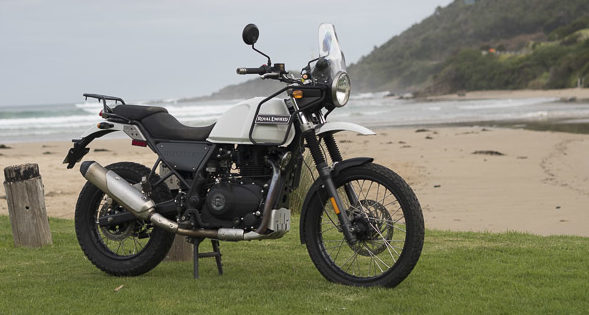
Report by Nigel Paterson, Photos Jeff Crow
Have you ever missed the view? You’re so focused on the riding you completely miss the scenery?
I have, many times – arrive first, basking in the self-centered glory of winning a race no-one else on the ride realised was a race only to have them regale stories of the rock formations, eagles or raging white water creeks, all of which I missed because I was more concerned with gear selection, redline and braking points.
Sometimes, slower is better.
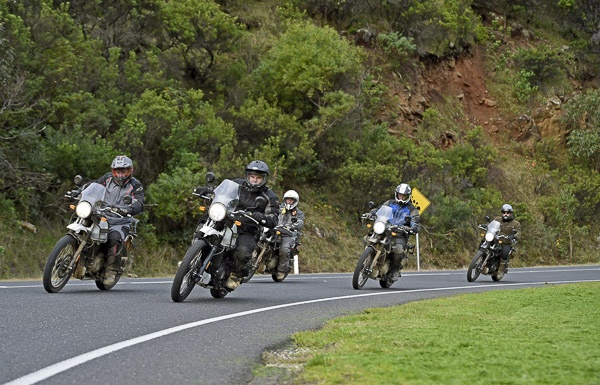
I really discovered this on a couple of tours. When I did Cape York last century my dirt bike skills were, let’s say, sadly lacking. I crashed my brains out on the first day and spent the next seven concentrating so hard on not dying that I saw nothing but the track in front of me if the engine was running.
Years later I toured Vietnam with Vietnam Motorcycle Tours on sub-200cc cruisers and had a ball – outside of the cities the riding was a doddle, little concentration required.
I saw so much…
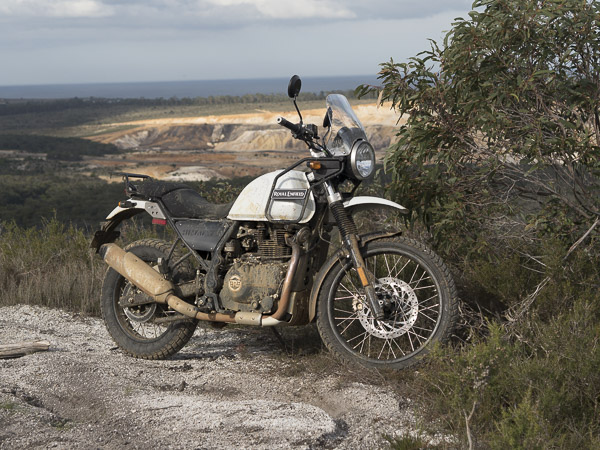
I’m telling this story because it’s how the Royal Enfield Himalayan makes me ride. A bit slower, a bit more touristy and a bit less full-on action.
Don’t get me wrong, I love big, powerful Adventure bikes – I’ve even owned a few – and I’ll own more in the future. They are incredible machines… but the Himalayan isn’t one of them.
It’s for the slower tour, the rider looking for an adventure, not an adrenalin-filled, tyre-tearing, mono-pulling extreme-sport style adventure, but one in which they can sit around the fire and say “I rode there”.
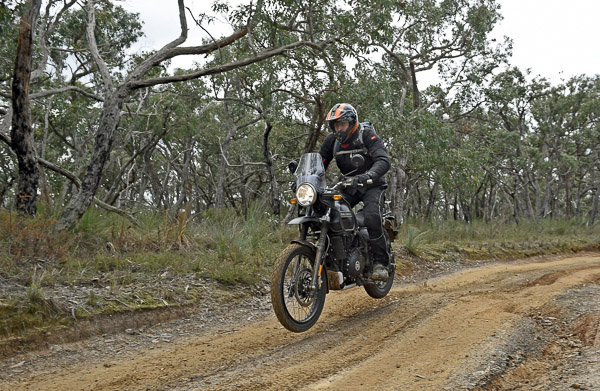
Retro Style…
Unless you have a penchant for ’70s-inspired Scramblers crossed with ’50s-inspired British singles I struggle to see how you could love the appearance and style of the Himalayan. It’s got to being in the running for ugliest motorcycle currently available today. While there are hints of 1990’s BMW R100GS styling in the crash bars running up to become headlight mounts, the industrial design is brutish and functional.
Seriously not pretty, even among Adventure bikes, which are never particularly attractive.
Get past the appearance though and there’s a motorcycle like no other underneath. Whether that’s a good thing depends a lot on what you want in a motorcycle – there’s certainly no traction control, ABS, riding modes, cruise control, Bluetooth, heated handgrips… but I think there’s a coffee percolator in there somewhere.
The guys at Urban Moto, the Australian importers, tell me a lot of Royal Enfields are being sold to Uni students in Melbourne, many of them foreign students… Indians of course. People with experience with the brand, young men (well, mainly men) who grew up with Mum & Dad getting around on a Royal Enfield, so they buy them because they are cheap, easily maintained with a basic toolkit and reliable once you understand a few foibles.
Once upon a time all bikes had foibles, they were included in the build. You learned about them and got by – I carried spare Moto Guzzi throttle cables on my Le Mans…
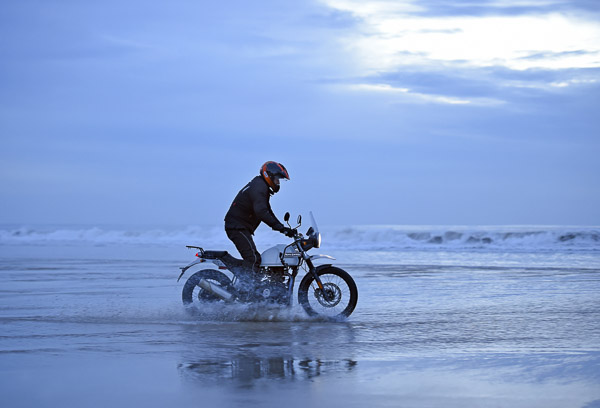
New design everywhere
The reality is the Himalayan is not a parts-bin special. The chassis was designed by the Harris Brothers, the British Company which has experience in all sorts of custom and bespoke frames, including 500cc Grand Prix machinery. Royal Enfield liked the company so much, they bought it…
Harris came up with a half-duplex split cradle design, a modern interpretation of the traditional British Bike Frame, albeit with a monoshock – the first we’ve seen on a Royal Enfield.
The engine’s also a new design, complete with a counterbalancer to reduce the thump of a single-cylinder engine. Dubbed the LS410 (Long Stroke), it’s a sweet motor, but more on that later.
The new engine has enabled Royal Enfield to simplify its building processes in a modern production line, reducing costs and improving quality – Royal Enfield claim this engine will last a long time because it’s understressed. Cooling is air/oil – in addition to the engine finning there are oil jets firing the black stuff around the inside of the motor and a separate oil cooler mounted on the frame’s main downtube.
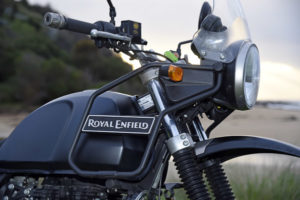
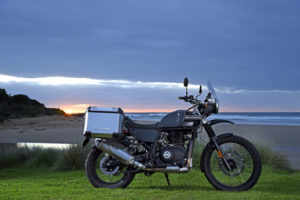
A traditional package…
Turn on the fuel, pull out the clutch, tickle the carburettor… OK, I’m pulling your leg there, you don’t need to tickle the carburettor – but the Himalayan does have a fuel tap, a manual clutch and a carburettor. If there were a kick-starter it’d be really old school… but no, there’s a button which proved totally reliable in the two days I had the bike for.
Do customers want carbs, fuel taps and manual chokes? I don’t, but I can see the attraction for some, either those who understand how to maintain and troubleshoot these things (including myself, to an extent) or those who want to learn. Certainly if something goes wrong in the back of nowhere, you’re more likely to find a farmer who can clean out a carb than prime a fuel injection system, but I’m inclined to think a modern injection system will be less likely to go wrong… the importer mentioned something about Royal Enfield choosing a carburettor so problems with bad fuel in the Himalayas could be easily drained and replaced, but I was thinking how carburettor jetting is thrown out of whack by high altitudes (regardless of fuel quality), so there’s pros and cons to everything.
But don’t be surprised if a future upgrade to the bike is EFI…
Once running, the mill required a few minutes to warm-up on the cold June morning of the launch. Then it was simply snick the five-speed ’box into first and head out into the Melbourne traffic…
I quickly discovered the Himalayan would make a nice commuter bike. You sit up relatively high, which gives a great view. The long-travel suspension and trail-style wheels means jumping kerbs is easy, there’s a sidestand and centrestand for easy parking and there’s a rack on the back standard for some gear or a small box.
You don’t get fancy adjustable alloy levers, Bluetooth in the instruments or ABS. But you do get an LCD compass in the instruments…
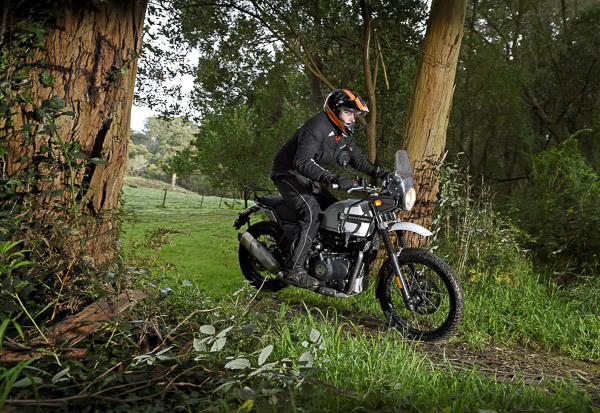
The engine
The LS410 motor actually displaces 411cc. I don’t know why they didn’t call it the LS411. Anyway, it’s a nice, tame, flexible motor. With just 24.5 horsepowers and 32 Newtowns, you’d have to be coming from a pushbike to think this thing is powerful, but that said, I don’t think that’s going to matter to the target audience.
If you’re looking for a performance machine you’ll be looking elsewhere anyway, and the LS410 motor offers a very pleasant ride, predictable acceleration and decent highway cruising. Its top speed will get you a ticket on the freeway rather than arrested. It’s comfortable cruising speed is around 100km/h, although I reckon when they are run in they might feel good a little quicker – our were very fresh.
The five-speed transmission seems one short by modern standards, but I didn’t miss having sixth. A low-revving top gear is great on a big bike to reduce fuel consumption and smooth our the ride, but it won’t help a 411cc, 24hp engine much.
This is easily the best road bike Royal Enfield has ever built, the counterbalancer smoothing out the vibes… not completely, but significantly. I can ride a Himalayan all day without a drama, and I’d even be happy to do so if I added a Sheepy Hollow Sheepskin or Airhawk seat.
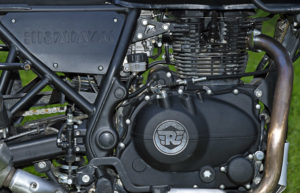
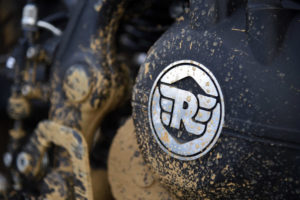
The ride
The Himalayan is an adventure bike with a low seat. Seriously, 800mm is not a high seat, in fact it was too low for me… with 220mm of ground clearance, the distance between the footpegs and seat was too short for my long-term comfort – but then, I’m not exactly short. I’d like a taller, flatter seat – more padding sure, but it would also reduce the distance required to stand up, which would make life easier off-road, although not as good for shorter riders. And Royal Enfield didn’t actually design the bike thinking its primary customer would be six-foot tall Caucasian males…
Up front there’s a small screen which takes the buffeting breeze off your chest, traditional-looking instruments which are actually quite comprehensive and a smallish fuel tank – 15 litres, laughable really for an adventure bike, but the fuel consumption – around 20km/L – means a range of up to 300km, which isn’t so bad.
At 182kg ready to ride, the Himalayan is very light for an adventure bike, which is probably why the traffic-light acceleration seemed more than acceptable – I could get the bike in front of the traffic easily. Around town in the 60-90km/h range it is easy to handle and ride, on the highways at 100-120 it is reaching the end of its comfort zone.
Stopping the bike is a disc at each end and while I liked the feel and power of the back brake, the front feels like many 1980s Italian brakes – lacking in feel and power, surprisingly on and off the bitumen.
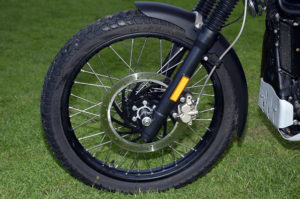
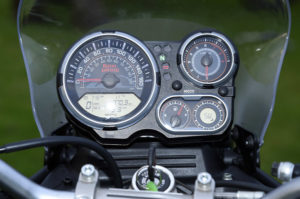
If you haven’t ridden modern bikes with their great stoppers this might not be something you really notice, for the brakes are acceptable, but they aren’t nice to use, although maybe they will improve when they’ve had a chance to bed in.
The first part of our ride took us from Melbourne to the Great Ocean Road, instead of the twisties we hit the trails. While we enjoyed morning tea Royal Enfield staff dropped tyre pressures and removed the runner footpeg inserts, exposing the serrated metal off-road footpegs, essential for the muddy conditions we were about to experience.
I wasn’t feeling confident on the Himalayan in off-road conditions, it just seemed too tame, too retro, too much of a styling exercise to work off road… but it does, at least to its design brief, which is more ‘any road’ than ‘any trail’.
Standing up on the pegs is certainly part of the design brief, but these aspects weren’t designed by an enduro rider – the tank feels too far forward to grip with your knees and there’s a frame rail under the seat which my legs pressed against while standing. This is one aspect where the design falls down, but take this in context – if you’re an experienced dirt bike rider you’ll find lots of things to dislike. The Himalayan is designed for roads and, realistically, four-wheel-drive tracks. It’s not the sort of bike many owners will spend their time standing on their footpegs, but yes, I still heartily recommend you do so in any sort of tricky off-road conditions.
We crossed a couple of creeks, we kept it on the throttle in the sand, we got cross-rutted on a downhill, we slipped and slid on Victorian clay… and the Himalayans kept on keeping on, eating the miles and taking us from scenic view to scenic view.
Sometimes it’s about performance and sometimes it’s about the journey.
If you’re looking for high performance, look elsewhere. If you’re looking for solid performance, the Himalayan might be for you.

What do I think?
It’s quite possible, were we to run a poll, that the Royal Enfield Himalayan would be voted the ugliest bike available today. However, it looks better in the metal and there are certainly many people who love the retro look and would like a retro-styled adventure bike.
And there’s others who know you’re not really looking at a bike when you’re riding it.
And others who will see a lot of Adventure in their future when the machine is priced at just $5,990 (+on-road costs).
Personally I enjoyed the Himalayan a lot more than I expected, and doing some crazy across Australia or across the Himalayas on a Royal Enfield Himalayan would be an absolute blast. Indeed, if the tour companies around the world using Royal Enfield machines don’t update to Himalayans, they’ve got rocks in their heads…
Royal Enfield has produced a bike which is totally identifiable as their own, yet it offers so much more than anything the company has offered before, and at a price which is pretty amazing.
I’ve no doubt people will have amazing adventures on their Himalayans.
More information at the Royal Enfield Australia website.


Nice review, which conveys the essentials while providing the tactile essence of the experience. This type of report is much more content rich than the usual male ego masquerading as reportage, and was enjoyable to read.
Wow! What a lovely, well-written review/ adventure tale. I really enjoyed reading this and agree the Himalayan is a lovely bike on and off road.